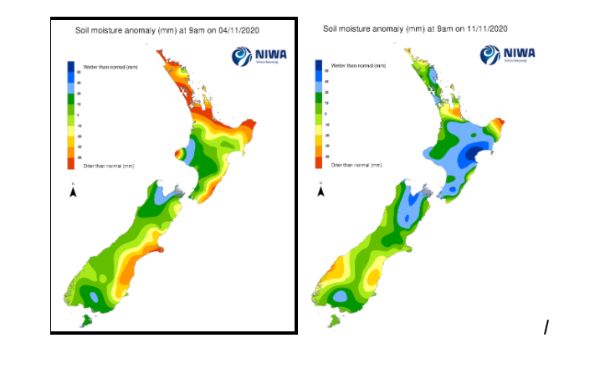NIWA's Hotspot Watch
A weekly update describing soil moisture patterns across the country to show where dry to extremely dry conditions are occurring or imminent. Regions experiencing significant soil moisture deficits are deemed “hotspots”. Persistent hotspot regions have the potential to develop into drought.
Facts: Soil Moisture
In the North Island, heavy rainfall in excess of 50 mm occurred in most locations during the past week. However, substantially more fell in parts of eastern Bay of Plenty and Hawke’s Bay, where more than 150 mm was observed. This included 242.4 mm in Napier between 9 am Monday and 9 am Tuesday (9-10 November), which was 463% of Napier’s normal November rainfall in only 24 hours, and Napier’s 2nd-wettest day on record since 1870. Significant flooding and slips occurred in Napier due to this near-record rainfall. The widespread heavy rainfall during the past week resulted in large soil moisture increases across all of the North Island. The driest soils across the North Island, when compared to normal for this time of the year, are found at the tip of East Cape. Meanwhile, the wettest soils for this time of the year are now located in Hawke’s Bay.
While a small hotspot remains in place in East Cape, the previous hotspots located in Auckland and on Aupouri Peninsula both dissipated during the past week.
In the top half of the South Island, significant rainfall amounts generally in excess of 30-50 mm were observed in most locations. However, from southern Canterbury to Southland, rainfall amounts were generally less than 25 mm. This resulted in moderate to large soil moisture increases across the northern and eastern South Island, while moderate soil moisture decreases occurred in Fiordland and the lower West Coast. The driest soils in the South Island compared to normal for this time of the year are now located in Fiordland and southern Westland, while the wettest soils for this time of the year are found in and around Nelson.
The previous hotspot running along much of coastal Canterbury dissipated significantly during the past week, and hotspot conditions are now only found in a small part of coastal Waitaki District.
Outlook and Soil Moisture
Mostly if not entirely dry weather will occur through the upcoming weekend as high pressure sits over and to the east of the North Island. A front will cross the North Island on Monday (16 November), bringing about 5-15 mm to upper and western areas. After dry weather on Tuesday, a stronger front will arrive on Wednesday, bringing moderate rain to primarily the western half of the North Island. Scattered showers may then occur on Thursday (19 November). Weekly rainfall totals may reach 15-30 mm in western areas, with up to 15 mm in most other areas. However, the east coast is likely to receive less than 10 mm.
Due to the expected rainfall over the next week, most areas will likely see little change to current soil moisture levels. However, small soil moisture decreases are likely along the east coast. However, new hotspots are unlikely to form during the next week.
In the South Island, dry weather is expected through Saturday for most locations, but moderate rainfall will be possible between Sunday and Monday as developing low pressure moves across the region. By Wednesday (18 November), another low has the chance to bring additional moderate rain to parts of the upper South Island. Weekly rainfall totals may exceed 75 mm across much of the West Coast, with more than 100 mm possible in Fiordland. While 25-40 mm will be possible across Otago and Southland, amounts generally less than 20 mm will be found from central Canterbury to Marlborough.
Significant soil moisture changes are not expected during the next week, although small increases may occur in the West Coast and lower South Island, with small decreases possible from central Canterbury to Marlborough. The current hotspot in coastal Waitaki District may weaken a bit more, and no new hotspots are expected to form.
Background:
Hotspot Watch: a weekly advisory service for New Zealand media. It provides soil moisture and precipitation measurements around the country to help assess whether extremely dry conditions are imminent.
Soil moisture deficit: the amount of water needed to bring the soil moisture content back to field capacity, which is the maximum amount of water the soil can hold.
Soil moisture anomaly: the difference between the historical normal soil moisture deficit (or surplus) for a given time of year and actual soil moisture deficits.
Definitions: “Extremely” and “severely” dry soils are based on a combination of the current soil moisture status and the difference from normal soil moisture (see soil moisture maps at https://www.niwa.co.nz/climate/nz-drought-monitor/droughtindicatormaps)
Hotspot: A hotspot is declared if soils are "severely drier than normal" which occurs when Soil Moisture Deficit (SMD) is less than -110 mm AND the Soil Moisture Anomaly is less than -20 mm.

As of 10 November, the New Zealand Drought Index (NZDI) map below shows that dry or very dry soils are located in several coastal areas, but meteorological drought is not currently found in New Zealand.

Please note: some hotspots in the text above may not correspond with the NZDI map. This difference exists because the NZDI uses additional dryness indices, including one which integrates the rainfall deficit over the past 60 days. Changes are therefore slower to appear in the NZDI compared to soil moisture anomaly maps that are instantaneously updated.


 Gordon Campbell: On bird flu, AUKUS entry fees and Cindy Lee
Gordon Campbell: On bird flu, AUKUS entry fees and Cindy Lee NZ Government: New Lab To Help Protect Key Pacific Tuna Fisheries
NZ Government: New Lab To Help Protect Key Pacific Tuna Fisheries Susan Botting - Local Democracy Reporter: Ruawai Leader Slams Kaipara Council In Battle Over $400k Property
Susan Botting - Local Democracy Reporter: Ruawai Leader Slams Kaipara Council In Battle Over $400k Property Te Pati Maori: Another ‘Stolen Generation’ Enabled By Court Ruling On Waitangi Tribunal Summons
Te Pati Maori: Another ‘Stolen Generation’ Enabled By Court Ruling On Waitangi Tribunal Summons Peace Action Wellington: Die In for Palestine Marks ANZAC day
Peace Action Wellington: Die In for Palestine Marks ANZAC day Labour Party: Penny Drops – But What About Seymour And Peters?
Labour Party: Penny Drops – But What About Seymour And Peters? Government: PM Announces Changes To Portfolios
Government: PM Announces Changes To Portfolios


